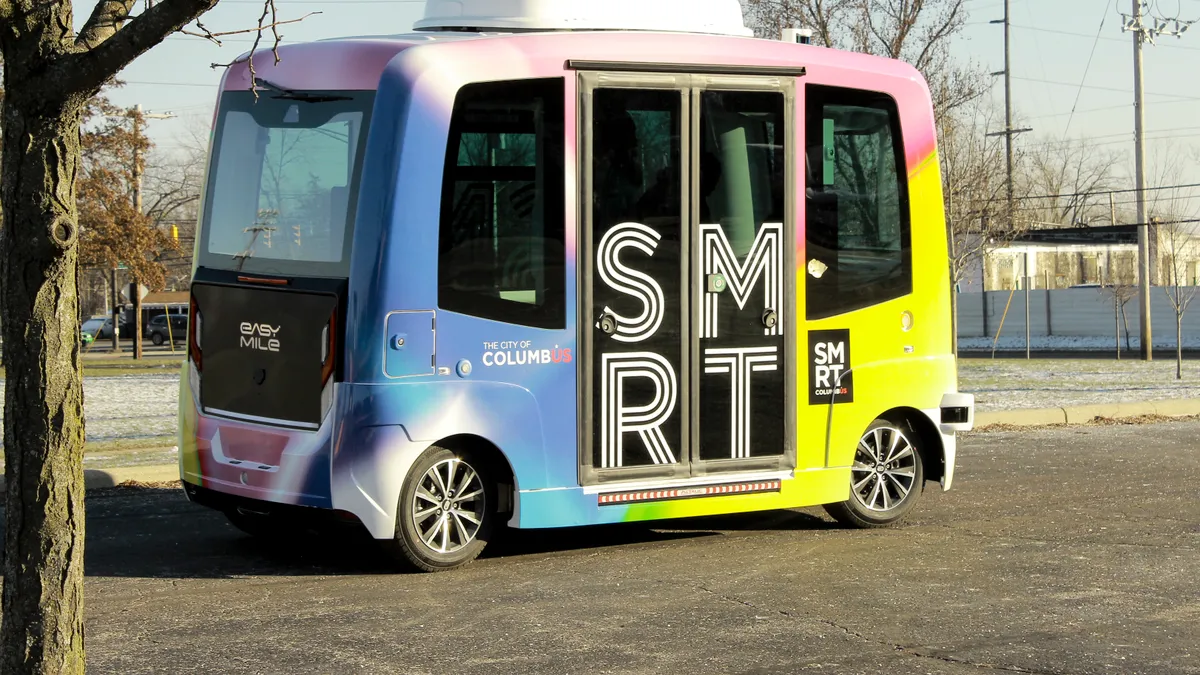UPDATE, May 19, 2020: The National Highway Traffic Safety Administration (NHTSA) outlined conditions to lift the suspension of EasyMile vehicles, following a February incident when Smart Columbus' Linden LEAP shuttle braked for an unknown reason, resulting in a woman falling from her seat. Sixteen shuttles were suspended across 10 U.S. cities as a result of the incident.
A review found that an internal safety mechanism was triggered when the Linden LEAP shuttle pulled away from a stop, which activated the vehicle’s sudden brake.
"It was the safest response, but unfortunately led to a passenger falling from her seat. It is also what can occasionally happen in other public transport like subways or trams, but in those, the braking is more abrupt," the EasyMile statement reads.
Service will resume as COVID-19 measures permit and as updates are made in accordance with a new Safety Passenger Enhancement Plan, devolped by EasyMile and NHTSA. Those efforts include adding seat belts to shuttles; increasing awareness about sudden stops by adding signage and audio enhancements; and training safety operators to remind passengers to hold on.
Dive Brief:
-
The National Highway Traffic Safety Administration (NHTSA) has ordered autonomous shuttle company EasyMile to suspend service for 16 of its shuttles across 10 U.S. cities, after a Smart Columbus shuttle made a sudden stop and a 44-year-old woman fell from her seat, according to City of Columbus, OH spokesperson Alyssa Chenault.
-
The Smart Columbus Linden LEAP shuttle was moving at 7.1 miles per hour with two passengers and a human operator aboard. The vehicle was moving from the Douglas Recreation Center stop when it braked suddenly for an unknown reason, she said.
-
EasyMile has been conducting an on-site review of the Columbus shuttle since Tuesday, according to Chenault. The services will resume once approval is given by NHTSA, which she said could be in about a week.
Dive Insight:
The free Smart Columbus shuttle service was launched as a one-year pilot in early February in the city’s Linden neighborhood, which is also identified as an opportunity zone.
The two shuttles, funded with over $1.1 million of the city's $50 million U.S. Department of Transportation (USDOT) grant, were designed to fill first mile/last mile gaps for the community by picking residents up from locations like the community recreation center, the Linden Transit center and child care and senior services.
The incident could potentially deter potential self-driving shuttle users from trusting or riding in the vehicles. The accident in Columbus could also raise questions about the safety of launching an autonomous pilot shuttle for seniors and vulnerable groups before the city fully understands how the new technology will operate and interact with existing street conditions.
"NHTSA will continue to work with all affected parties, including EasyMile and local authorities, to evaluate potential future vehicle operations, consistent with applicable legal requirements and public safety," a NHTSA spokesperson told Smart Cities Dive via email.
This isn’t the first time an autonomous shuttle pilot program experienced some setbacks. Las Vegas launched a service in 2017 that was involved in a minor accident when a delivery truck backed into the shuttle shortly after the shuttle started running.
One of the main criticisms stemming from that accident was that human drivers are not ready for autonomous vehicles to be on the road. The driver that backed into the shuttle did make an illegal move, but likely expected the shuttle to move out of its way — not knowing that the vehicle wasn’t being operated by a human.
However, the accident in Las Vegas did not appear to deter users. Many of the city's 20 million annual visitors were still curious about the shuttles after hearing about the incident on the news or social media. In total, the shuttle attracted over 32,000 riders from November 2017 to October 2018.
Columbus spokesperson Chenault said the city has conducted some public education to make residents aware about how to interact with the vehicles. Signage and operators remind passengers to "hold on" due to the risk of sudden stops, she said. The public is also told to maintain a safe distance from the shuttles when driving due to any unplanned stops to prevent rear end collisions.
"With this being a new technology, people aren’t sure what to expect, and so that's a responsibility for us as a city to educate residents on how to safely ride the vehicle," she said.












